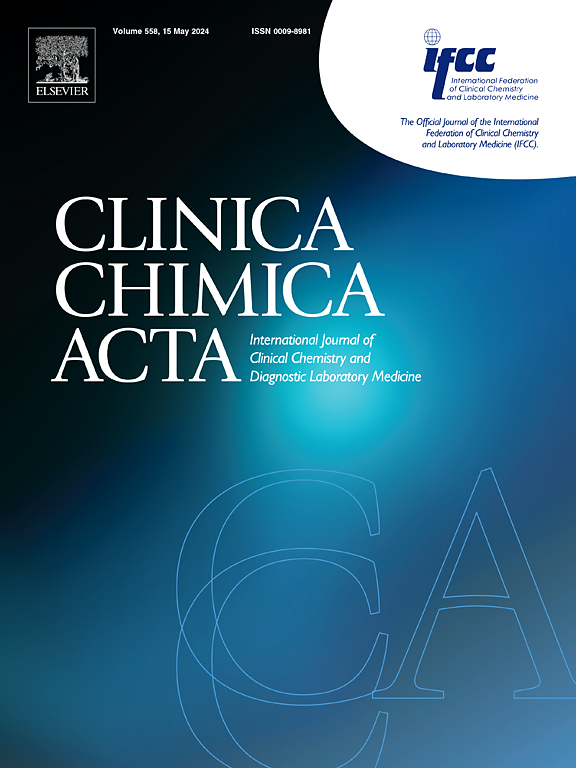Identification of a panel of lncRNAs derived from urinary extracellular vesicles as non-invasive diagnostic biomarkers for bladder cancer
IF 2.9
3区 医学
Q2 MEDICAL LABORATORY TECHNOLOGY
引用次数: 0
Abstract
Bladder cancer (BLCA) is a common malignant tumor of the urinary system and is histopathologically divided into high-grade and low-grade BLCA. Accurate diagnosis of BLCA and high-grade BLCA are critical for clinical treatment and early intervention. High-throughput RNA-seq was performed to explore dysregulated long non-coding RNAs (lncRNAs) in urinary extracellular vesicles (uEVs) from BLCA patients, and their expression levels were examined in a large cohort of uEVs samples using qRT-PCR. We examined the expression levels and subcellular localization of the lncRNAs in BLCA tissues and cell lines. We analyzed the correlation between the expression levels of lncRNAs in uEVs and clinical parameters and assessed their clinical value as diagnostic biomarkers for BLCA and high-grade BLCA using receiver operating characteristic (ROC) curve. Through high-throughput RNA-seq, we identified several dysregulated lncRNAs (MALAT1, SCARNA10, LINC00963 and LINC01578) in uEVs from BLCA patients. The lncRNAs were significantly upregulated in uEVs of BLCA patients, however with varying expression levels in tissues and cell lines. The lncRNAs are predominantly localized in the nucleus of BLCA cell lines. Elevated expression levels of the lncRNAs were associated with adverse factors, including higher tumor grade and larger tumor diameter. ROC curve analysis showed that the combination of four lncRNAs in uEVs and the existing marker nuclear matrix protein 22 provided substantial diagnostic value for BLCA and high-grade BLCA, with area under curve values of 0.900 and 0.917, respectively. The lncRNA panel derived from uEVs may serve as a promising non-invasive biomarker for diagnosing BLCA and high-grade BLCA.

鉴定来自尿细胞外囊泡的一组lncrna作为膀胱癌的非侵入性诊断生物标志物。
膀胱癌(BLCA)是泌尿系统常见的恶性肿瘤,在组织病理学上分为高级别和低级别BLCA。准确诊断BLCA和高级别BLCA对临床治疗和早期干预至关重要。采用高通量rna测序技术研究了BLCA患者尿细胞外囊泡(uEVs)中失调的长链非编码rna (lncRNAs),并利用qRT-PCR技术在大量uEVs样本中检测了它们的表达水平。我们检测了lncrna在BLCA组织和细胞系中的表达水平和亚细胞定位。我们分析了lncrna在uev中的表达水平与临床参数的相关性,并利用受试者工作特征(ROC)曲线评估其作为BLCA和重度BLCA诊断生物标志物的临床价值。通过高通量RNA-seq,我们在BLCA患者的uEVs中发现了几种失调的lncrna (MALAT1, SCARNA10, LINC00963和LINC01578)。lncrna在BLCA患者的uev中显著上调,但在组织和细胞系中的表达水平不同。lncrna主要定位于BLCA细胞系的细胞核中。lncrna表达水平升高与肿瘤分级高、肿瘤直径大等不利因素相关。roc曲线分析显示,uEVs中4种lncrna与现有标记物核基质蛋白22的结合对BLCA和高级别BLCA具有较强的诊断价值,曲线下面积分别为0.900和0.917。来自uev的lncRNA面板可能作为诊断BLCA和高级别BLCA的有前途的非侵入性生物标志物。
本文章由计算机程序翻译,如有差异,请以英文原文为准。
求助全文
约1分钟内获得全文
求助全文
来源期刊

Clinica Chimica Acta
医学-医学实验技术
CiteScore
10.10
自引率
2.00%
发文量
1268
审稿时长
23 days
期刊介绍:
The Official Journal of the International Federation of Clinical Chemistry and Laboratory Medicine (IFCC)
Clinica Chimica Acta is a high-quality journal which publishes original Research Communications in the field of clinical chemistry and laboratory medicine, defined as the diagnostic application of chemistry, biochemistry, immunochemistry, biochemical aspects of hematology, toxicology, and molecular biology to the study of human disease in body fluids and cells.
The objective of the journal is to publish novel information leading to a better understanding of biological mechanisms of human diseases, their prevention, diagnosis, and patient management. Reports of an applied clinical character are also welcome. Papers concerned with normal metabolic processes or with constituents of normal cells or body fluids, such as reports of experimental or clinical studies in animals, are only considered when they are clearly and directly relevant to human disease. Evaluation of commercial products have a low priority for publication, unless they are novel or represent a technological breakthrough. Studies dealing with effects of drugs and natural products and studies dealing with the redox status in various diseases are not within the journal''s scope. Development and evaluation of novel analytical methodologies where applicable to diagnostic clinical chemistry and laboratory medicine, including point-of-care testing, and topics on laboratory management and informatics will also be considered. Studies focused on emerging diagnostic technologies and (big) data analysis procedures including digitalization, mobile Health, and artificial Intelligence applied to Laboratory Medicine are also of interest.
 求助内容:
求助内容: 应助结果提醒方式:
应助结果提醒方式:


